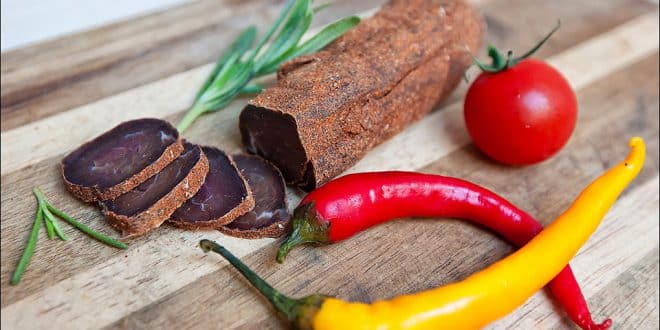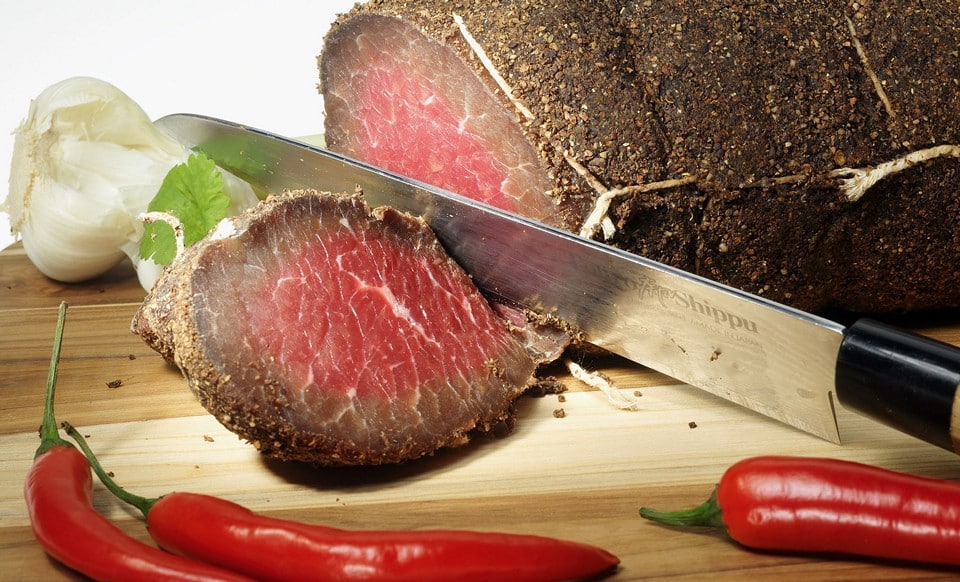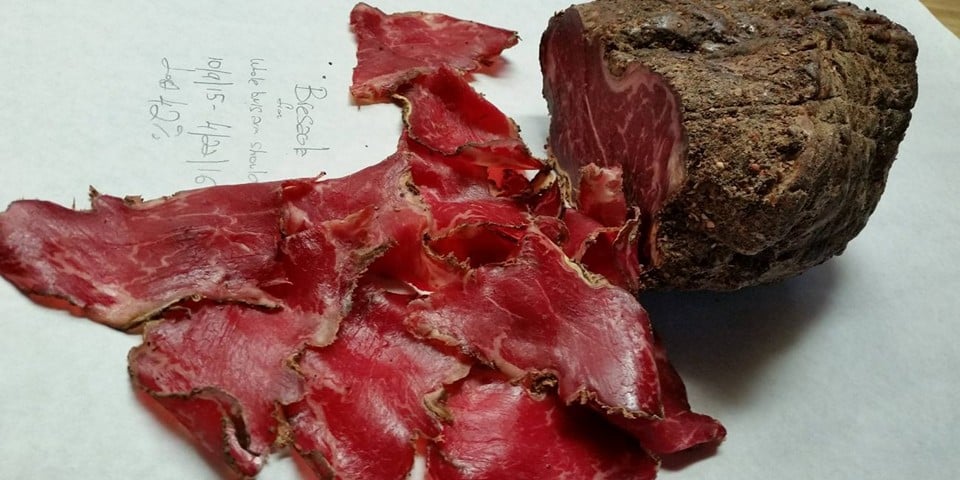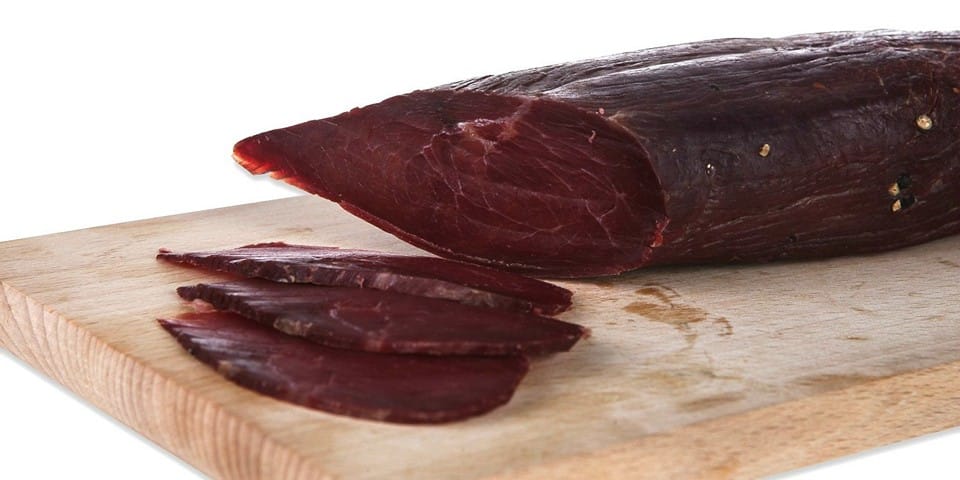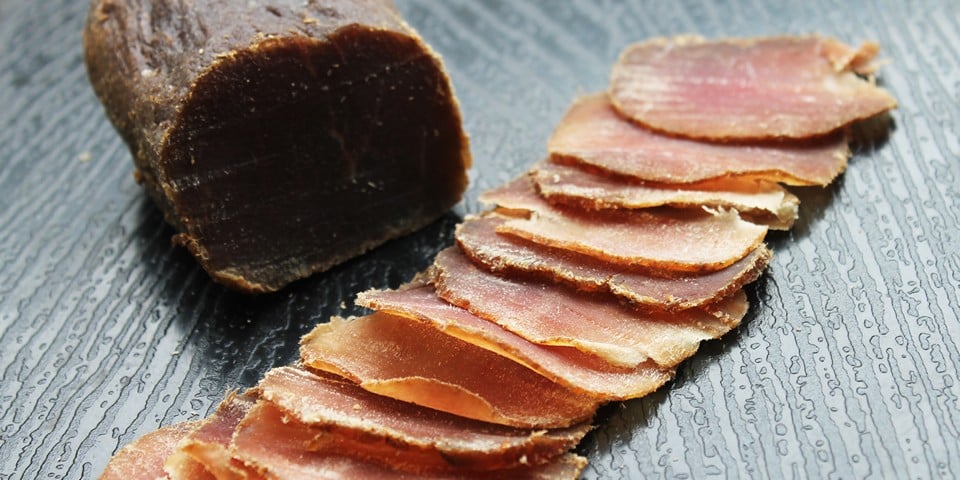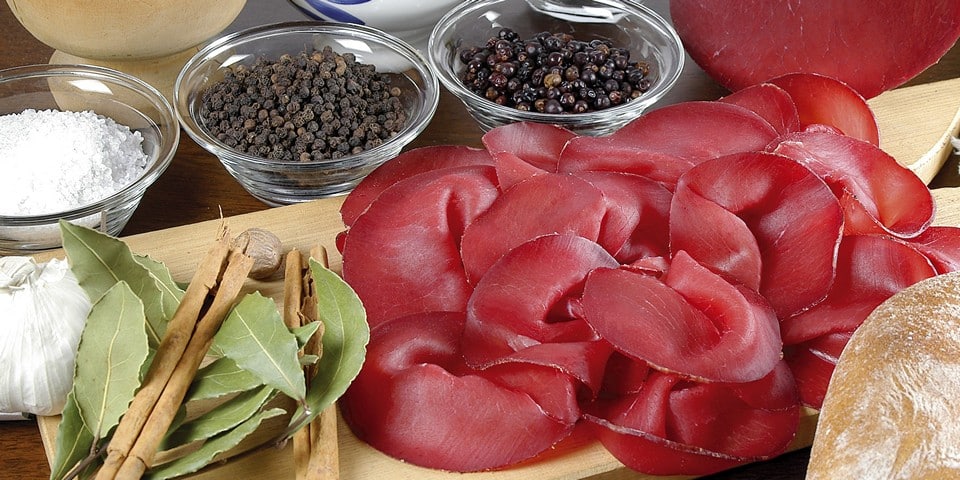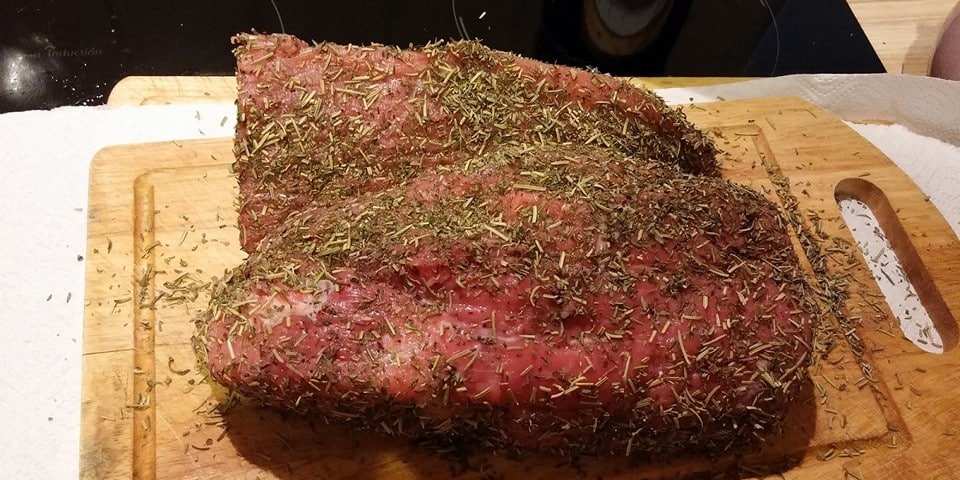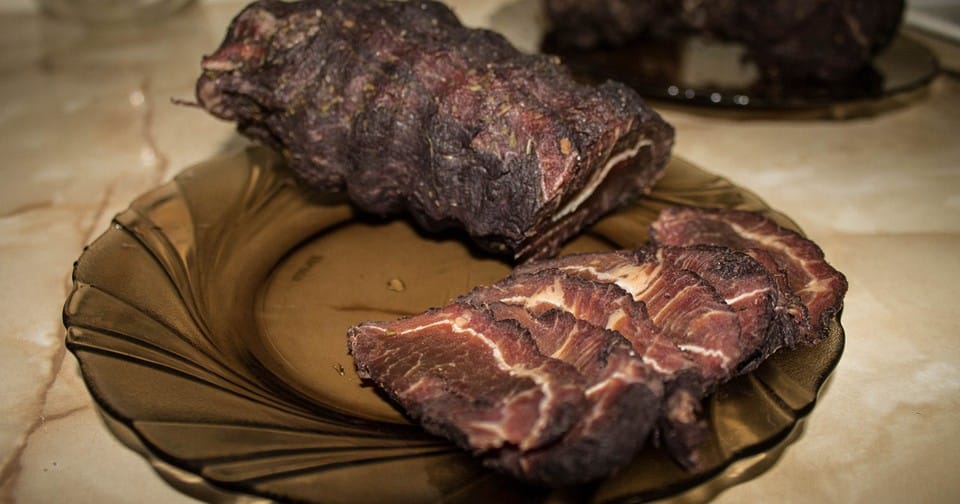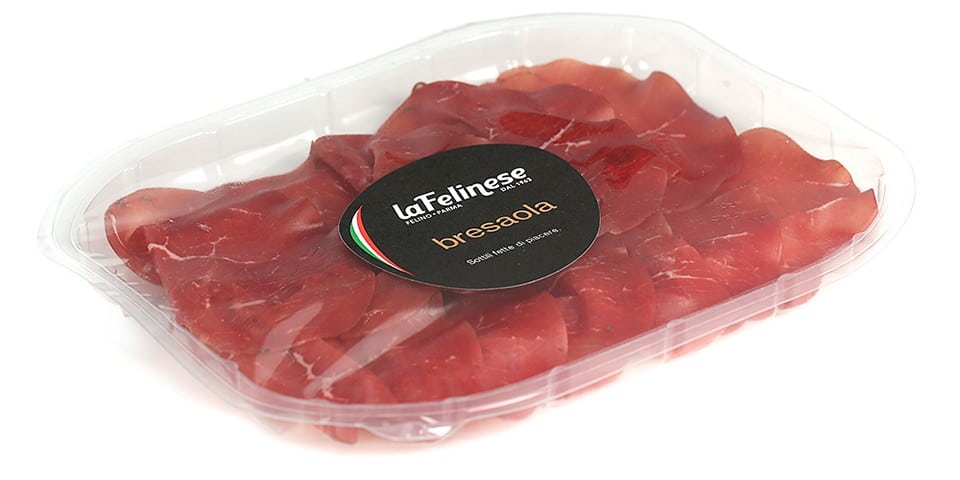Most Italian meat products are made from pork. However, there is always at least one exception to every rule. In the list of dishes that are far from vegetarian, Bresaola stands out from its “siblings.” It is made from air-dried beef. In some northern regions of Italy, versions made from venison and horse meat can also be found.
Nevertheless, according to the Istituto Valorizzazione Salumi Italiani, Bresaola is the only type of Italian sausage that is prepared exclusively from beef. To uncover all the secrets and learn the recipe for preparing it at home, our article will be of help.
Page Contents
The Origins of Bresaola
The origins of Bresaola date back centuries. It is believed to have emerged with the first methods of preserving meat from wild animals through salting and air-drying.
The term “bresaola” likely derives from the Latin word “brasaula,” meaning “salted, roasted meat,” as the initial drying stages took place in rooms heated by fire.
The first documented evidence of air-dried beef preparation dates back to the 15th century. However, until the 19th century, the recipe remained within the confines of family meals. It was only with the development of the industry that the production of Bresaola took on a large-scale character. The product crossed the borders of Italy and began to be exported to Switzerland.
In 1996, Bresaola della Valtellina was granted the Protected Geographical Indication (IGP) status, a distinctive mark emphasizing its unparalleled quality.
Description
Bresaola is a cured beef product. In its finished form, it has a cylindrical shape, dark red color, and a spicy, meaty aroma. There may be slight marbling in the form of thin white streaks of fat. The taste is moderately salty.
Bresaola della Valtellina is a benchmark for quality among the wide range of beef delicacies. Let’s take a closer look at how it is produced on an industrial scale.
Industrial production
Only the muscles from the front and rear limbs are used to make the product. All the raw materials go through a meticulous selection process, which is a necessary condition for obtaining a high-quality product. The specialists then trim excess fat and tendons without affecting the flesh.
The second stage is dry salting. Pieces of meat are sprinkled with salt and spices in vats. Adding wine, sugar, and minimal amounts of sodium or potassium nitrites or nitrates is permissible. Each company keeps the spice proportions a secret, so the taste and aroma of the delicacy vary from manufacturer to manufacturer.
The salting stage lasts for at least 10 days and concludes with a unique “massage” that ensures even penetration of salt into the muscle tissue.
Then, the bresaola, rinsed of excess salt, is placed in a natural or artificial casing and sent for drying. During the first week, intensive dehydration of the product occurs at an air temperature of 20-30 degrees Celsius (68-86 degrees Fahrenheit).
Further maturation takes place at a temperature of 12-18 degrees Celsius (53.6-64.4 degrees Fahrenheit) for 4-8 weeks. The production rules prohibit the use of accelerated aging methods for meat products.
The finished bresaola is sold as a whole or sliced and vacuum-sealed.
Non-traditional Varieties
In certain regions of Italy, non-traditional varieties of this delicacy are produced:
- Bresaola di cavallo – bresaola made from horse meat. This distinctive product is from the provinces of Asti and the Veneto region. The meat used comes from the hindquarters of the animal, devoid of fat and tendons.
- Bresaola di cervo – bresaola made from venison. It is typical of the city of Novara. It is prepared from the thigh or shoulder muscles of deer. The raw meat is marinated in a brine based on red wine. The drying and aging stages are similar to the traditional method.
- Bresaola affumicata – smoked beef from the province of Sondrio. After the delicacy has matured, it undergoes a smoking process using pine wood.
How to Enjoy and Pair
Bresaola is an exquisite product that requires an extraordinary approach to tasting. The slices should be no thicker than 0.8mm. Only in this way can you fully appreciate the tenderness and aroma of the delicacy. Chewing it slowly with your mouth closed, allowing your taste buds to perceive all the nuances of the cured beef.
Bresaola is served slightly chilled or at room temperature. It can be enjoyed independently or drizzled with olive oil, lemon juice, or balsamic vinegar.
Italian hosts often use bresaola as an ingredient in various dishes. It pairs perfectly with sandwiches and makes an excellent carpaccio. It also harmonizes well with legumes, vegetables (arugula, tomatoes, bell peppers, zucchini), fruits (figs, pears, pomegranates, black grapes), and Parmesan cheese.
The ideal beverage to accompany bresaola is a flavorful white wine, which complements the spice notes of the product.
Recipe for Homemade Bresaola
Bresaola is one of the few meat dishes that has virtually no contraindications for consumption.
If you don’t have the opportunity to buy high-quality Italian bresaola or have doubts about the reliability of modern producers, then try making your own cured beef at home.
To yield approximately 1.5-1.75 lbs (700-800g) of bresaola, you will need 2.2 lbs (1 kg) of meat. During the preparation process, it will lose about 30% of its weight due to dehydration. It’s essential that the meat is lean and free from fat and tendons.
So, here are the required ingredients:
- Beef (round or shoulder) – 2.2 lbs (1 kg);
- Salt – 7 oz (200g);
- Sugar – 7 oz (200g);
- Rosemary, black pepper, sweet paprika – to taste.
First, we give the meat a cylindrical shape using a knife if the chosen beef doesn’t already resemble a cylinder. Then, we mix the salt, sugar, and finely chopped rosemary.
Rinse and pat dry the beef, then tie it with twine or use rubber bands to hold its shape. Coat the meat with the salt and spice mixture, rubbing it in thoroughly. The meat should be covered entirely with adhering crystals.
We place the prepared bresaola-to-be in a container with holes at the bottom and store it in the refrigerator, placing something underneath to collect any dripping liquid. After 24 hours, we drain the accumulated water and rub the meat again with the salt and spice mixture. We repeat this process several times over the course of a week.
After 7 days, we rinse the beef to remove excess spices using cold water or dry white wine. Then, we pat it dry with paper towels and rub it with a mixture of paprika and black pepper. Additional salt can be added to the spices, but in an amount not exceeding 0.04 oz (1g) per 3.5 oz (100g) of meat.
We wrap the semi-finished product in cotton cloth or paper towels and place it on a rack in the refrigerator for approximately 30 days. During the first week, we change the cloth every 2-3 days, and for the remaining curing time, we change it every 6-7 days to remove any excess moisture.
If, after a month, the beef has dried sufficiently, the product is ready for consumption.
We slice the homemade bresaola into thin slices and savor the excellent combination of taste and benefits.
Caloric Content and Benefits
It is not true that all sausage products are harmful to health. Bresaola, despite belonging to this category, completely disproves this statement. In 100g (3.5 oz) of the product, there are only 151 kcal. The energy value is composed of:
- Protein – 32g;
- Fat – 2.6g;
- Carbohydrates – 0g.
Unlike most sausages, bresaola contains minimal amounts of fat. This makes it an excellent choice for people following low-calorie diets and those with high cholesterol levels.
Dried beef is rich in high-quality proteins, making it a common component in the diets of athletes and those seeking to lose weight.
Bresaola contains a significant amount of iron (30% of the daily norm per 100g), making it recommended for preventing anemia.
The presence of potassium (10.74% of the daily norm) and phosphorus (24% of the daily norm) positively affects the maintenance of healthy bone tissue. Additionally, the B vitamins contribute to the proper functioning of the nervous system and metabolic processes.
Perhaps the only contraindication to consuming bresaola is hypertension.
Due to its significant sodium chloride content, it can lead to fluid retention in the body and an increase in blood pressure.
Price in Italy
Every exquisite product comes with an equally exquisite price. Bresaola is no exception in this regard. The price of Bresaola della Valtellina IGP in Italy averages around 45 Euros per kilogram (2.2 lbs).
The tale of this Italian delicacy, with its lean and flavorful taste, comes to an end. If you want to eat healthily without worrying about consumed calories, don’t pass by the counters with bresaola. Especially if those counters happen to be in Italy. Live harmoniously, read a lot, and everything else will fall into place!
Interesting Facts about Bresaola
- Bresaola is an Italian delicacy that dates back centuries. Its origins can be traced to the Lombardy region of Northern Italy, where it has been made since the 15th century.
- Bresaola is made from lean cuts of beef, typically the eye of round, which is carefully trimmed of all fat and sinew. The beef is then dry-cured with a blend of salt, spices, and herbs, such as juniper berries, black pepper, and rosemary.
- The curing process for bresaola can take anywhere from a few weeks to a few months, depending on the desired flavor and texture. During this time, the meat develops its distinct flavor profile and becomes tender through the action of salt and time.
- Bresaola is known for its deep, ruby-red color and delicate, melt-in-your-mouth texture. The thin slices of bresaola are typically served raw and are best enjoyed when thinly sliced and served at room temperature. It has a rich, beefy flavor with subtle hints of the herbs and spices used in the curing process.
- Bresaola is a versatile ingredient and can be enjoyed in various ways. It is commonly served as part of an antipasto platter or in salads, where ingredients like arugula can complement its flavors, shaved Parmesan cheese, lemon juice, and extra virgin olive oil.
- Traditional bresaola is made without additives or preservatives, relying solely on curing to preserve the meat. This makes it a healthier choice compared to some other cured meats that may contain added ingredients.
- Bresaola has gained international recognition and is highly regarded in the culinary world. It has received various certifications and protected designation of origin (PDO) status, ensuring that authentic bresaola is made following specific traditional methods and using quality ingredients.
 Italy for me From Italy with love
Italy for me From Italy with love

